
Table of Contents
Cervical cancer stage 1 falls in the class of early-stage cervical cancers(stages 1A, 1B, and 2A). It describes the stages where cancer remains confined within the cervix and hasn’t spread to nearby tissues. It is usually discovered from abnormal pelvic examinations or pap smears because it’s normally symptomless.
In this article, we’ll take a look at the divisions of stage 1 cervical cancer, the risk factors, symptoms, treatment, prognosis, and life expectancy.
The development of stage 1 cervical cancer.
It starts with cervical dysplasia which is the abnormal growth of cervical cells often triggered by a human papillomavirus infection. Cervical dysplasia is called the Precancerous stage which eventually leads to cervical cancer when not treated.
There are 3 levels of progressive Cervical dysplasia:
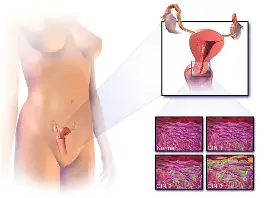
- Mild dysplasia (CIN I)
- Moderate to marked dysplasia (CIN II)
- Severe dysplasia to carcinoma in situ (CIN III)
(CIN means Cervical Intraepithelial Neoplasia).
12 risk factors of stage 1 cervical cancer.
1. Recurrent HPV infections.
2. Avoidance of regular screening. This is why continuous screening is important.
3. Missed Vaccination or uncompleted vaccination. The majority of people get infected with the human papillomavirus at some point in their lifetime. Vaccinations prepare your body’s defenses to fight off the infection when it occurs and completing your doses as recommended is what gives you adequate protection as mentioned in another article on the effectiveness of HPV vaccines.
4. Smoking. It increases your chances of coming down with cervical cancer following an infection. This is due to its negative effects on your immunity, and its interference with healing and recovery.
5. Unprotected sex. The majority of HPV transmissions are via sex. Unprotected sex leaves you exposed to the virus.
6. Multiple sexual partners. Studies have shown the more lifetime sexual partners you have, the higher your chances of contracting the virus.
7. Existing sexually transmitted infection. People with sexually transmitted infections are known to be at higher risk.
8. Use of oral contraceptives. This increases your risk if used for a long time.
9. Family history. For some reason, people with a family history of cervical cancer are at higher risk of coming down with the disease according to the American Cancer Society.
10. Exposure to Diethylstilbestrol (DES). This is a synthetic type of the female estrogen hormone. It was given to pregnant women from 1940 to 1971 to prevent miscarriages but was stopped after it was linked to higher risks of developing cancerous tumors as acknowledged by the National Cancer Institute.
Other factors include:
11. Early first-time sex. This influences the recommended age for vaccination. Vaccines are best given before exposure to the virus and the preteen ages of 11 to 12 years are targeted.
12. Early first pregnancy. Research involving 1864 cases and 1719 controls as published in the British Journal of Cancer associates early age of first sexual intercourse (AFSI), Age of first pregnancy (AFP), and age at first marriage (AFM) to an increased risk of invasive cervical carcinoma (ICC).1
Stage 1 cervical cancer divisions.
Staging is very important in classifying cervical cancers in line with the size, and extent of metastasis, and deciding on the best treatment measures. In line with the International Federation of Gynecology and Obstetrics, stage 1 cancer describes the early point at which cervical cancer remains confined within the cervix.
It is divided into stages 1A and 1B.
Stage 1A.
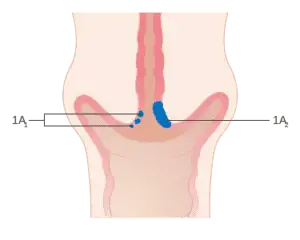
At this stage, the cancer is so small it has to be viewed with the help of a microscope or colposcope. Based solely on size, stage 1A is further divided into 1A1 and 1A2.
- Stage 1A1: This is when Cancer is less than 3mm deep.
- Stage 1A2: By this stage, it has grown to between 3-5mm.
Stage 1B.
This is distinguished from stage 1A based on sizes above 5mm and it’s further divided into 3 types.
Stage 1B1: At this stage, the cancer is more than 5mm but less than 2cm.
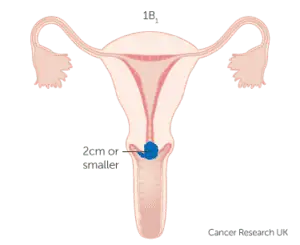
Stage 1B2: You get to stage 1B2 when it grows beyond 2cm but less than 4cm.
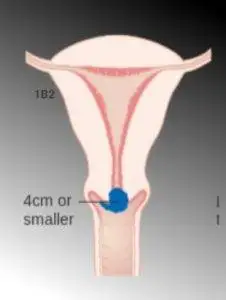
Stage 1B3: This is when the cancer is up to 4cm. From stage 1B3 it goes into stage 2A by the time it spreads to the upper parts of the vagina.
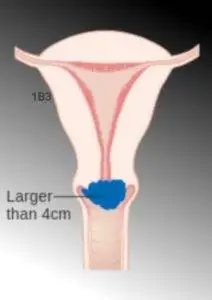
Symptoms of stage 1 cervical cancer.
Whereas stage 1 cervical cancers usually exist without symptoms, being early-stage cancer, it could still be discovered during regular screening. As it progresses, the later stages may show the following symptoms.
- Abnormal vaginal bleeding may occur in post-menopausal women and between menses in premenopausal women.
- Pelvic pain.
- Pain during intercourse.
- Foul-smelling vaginal discharge that may be watery, bloody, pink, or brown.
- Bleeding after coitus.
- Longer menses in premenopausal women.
Treatment for stage 1 cervical cancer.
Treatment for cervical cancer is decided based on a couple of factors, such as:
1. Stage of cancer: Stage 1, 2, 3, etc.
2. Type of cancer: Squamous, Adenocarcinoma, etc
3. Grade of cancer: Tells the extent to which the cancerous cells look like your normal cells. There are 3 grades:
- Grade1. Looks quite like normal cells.
- Grade2. Looks a bit like normal.
- Grade3. Quite abnormally looking cells.
4. Your age and medical history or existing medical conditions
5. Your personal preferences or expectations like if you still want to have children after treatment.
Possible medical options in treating cervical cancers include:
- Surgery.
- Radiotherapy.
- Chemotherapy.
For stage 1 cervical cancer, surgery is the main treatment. There are a couple of surgical procedures and the type chosen for you depends on certain considerations or factors as discussed above.
| Cervical cancer stage | Main surgery | The lymph nodes removed |
|---|---|---|
| 1A1 | Cone biopsy | None |
| 1A1 | Total hysterectomy | Lymph nodes may or may not be spared |
| 1A2 | Radical trachelectomy | Pelvic lymph nodes |
| 1A2 | Modified radical hysterectomy | Pelvic lymph nodes |
| 1B1 | Radical trachelectomy | Pelvic lymph nodes |
| 1B1 | Radical hysterectomy | Pelvic lymph nodes + Para-aortic lymph node samples. |
| 1B2 | Radical hysterectomy | Pelvic lymph nodes + Para-aortic lymph node samples. |
Your choice of surgery will depend on your desire to have children or not after the treatment. You’ll either have to settle for a cone biopsy, radical trachelectomy, or hysterectomy.
Cone biopsy: This is an excisional biopsy in which a cone-shaped piece of tissue is surgically removed within which are the cancerous cells. It’s a fertility-preserving procedure and applicable to stage 1A1.
Trachelectomy: This is a fertility-preserving procedure as well and involves the surgical excision of the cervix along with the upper parts of the vagina. It is ideal for younger women who desire to have children. The ideal mode of delivery after this procedure is a cesarean section.
Hysterectomy: This is for those who wouldn’t want to have babies after the treatment as it involves the removal of the uterus or womb. It is the main surgical treatment for stage 1B2 but applies to earlier stages of 1A1 to 1B1.
Radiotherapy or Chemoradiation: According to the Canadian Cancer Society, this comes into play in the following situations:
- When surgery is deemed not suitable for you for medical reasons.
- When you turn down the option of surgery.
- When cancerous cells are detected in the lymph nodes, in the blood or lymph vessels, near the edges of a tissue biopsy, or a removed organ.
In chemoradiation, external beam irradiation is given once daily, 5 times weekly for about 5 weeks. During the treatment, chemotherapy is given once weekly or after every 2 to 3 weeks.
For once-weekly chemotherapy, Cisplatin may be the drug of choice for you, and for once every 3 weeks of chemo, cisplatin plus 5-fluorouracil may be administered.
If this was helpful do keep in touch by subscribing to our newsletter:
Prognosis
Several factors are considered in determining your prognosis. These include the type of cancer, stage at diagnosis, age, tumor size, health, and HIV status.
Generally, the early stages of any cancer signify a better prognosis than its later stages. Also, the younger you are, the better. The size of the tumor has a lot to do with the stage and smaller sizes which may mean earlier stages, give a better prognosis.
Having an underlying disease like HIV will hurt your prognosis. In summary, where all these considerations are equal, cervical cancer stage 1 has a better prognosis than the later stages.
Life expectancy.
This will differ among individuals when the same factors are used to determine the prognosis. Cancer Research, UK has stated that about 95 out of every 100 women found to have stage 1 cervical cancer are known to live for the next 5 years from the date of diagnosis.
This doesn’t mean after 5 years everyone dies. The majority of treatments at this stage are quite successful and the patients live the rest of their lives cancer-free and in relatively good health. Some people do experience a recurrence though.
A study has shown oils with a higher omega-6/omega-3 ratio significantly increase the risk of mortality from cancer, and cardiovascular diseases.2 Sadly, the popular soybean, grapeseed, and sunflower seed oils have such ratios.
You may also want to find out exclusively about the locally advanced stage 3 and the advanced stage 4.
Reference.
- Louie, K. S., De Sanjose, S., Diaz, M., Castellsagué, X., Herrero, R., Meijer, C. J., Shah, K., Franceschi, S., Muñoz, N., & Bosch, F. X. (2009). Early age at first sexual intercourse and early pregnancy are risk factors for cervical cancer in developing countries. British Journal of Cancer, 100(7), 1191-1197. https://doi.org/10.1038/sj.bjc.6604974 ↩︎
- Yuchen Zhang, Yitang Sun, Qi Yu, Suhang Song, J Thomas Brenna, Ye Shen, Kaixiong Ye (2024) Higher ratio of plasma omega-6/omega-3 fatty acids is associated with greater risk of all-cause, cancer, and cardiovascular mortality: A population-based cohort study in UK Biobank eLife 12:RP90132
https://doi.org/10.7554/eLife.90132.3↩︎























































































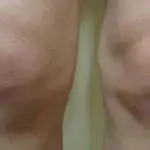


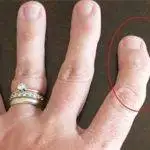

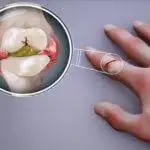


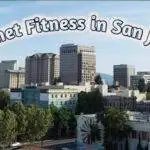

































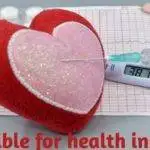




























I want to to thank you for this excellent read!! I absolutely enjoyed every bit of it. I’ve got you bookmarked in order to be updated on new things you post.
Also feel free to visit my web page.
I really like this in-depth information. kudos
Fascinating article. In my opinion, if all site owners and bloggers made excellent content as you do, the internet shall be a lot more helpful than ever before.